
|
MUTANT BIG CATS - RED, BROWN, STRIPELESS & DOUBLE-STRIPED TIGERS |
Mutants are natural variations which occur due to spontaneous genetic changes or the expression of recessive (hidden) genes. Recessive genes show up when there is too much inbreeding. In the past, the obvious reaction to any unusual big cat was to shoot it for the trophy room. As a result, many interesting mutations may have been wiped out before the genes were passed on. Some colour mutations which would disadvantage a wild big cat are bred in captivity and are not viable in the wild. It is questionable whether these mutants should be perpetuated for the sake of curiosity or aesthetics alone.
Historical quotations are credited and are in the public domain. Original text is licensed under the GFDL. I am grateful to Paul McCarthy and Mary Ann Howell for researching and providing extensive material, information and corrections on tiger mutations.
Brown and red tigers and other anomalies have also been reported. According to F G Alexander in Harmsworth Natural History (1910): Concerning the tiger’s coloration, my field of observation has been limited to Rajputana, Central India, and Bundelkhand, the jungles in which may be called " open jungles." The colour of all the tigers killed by myself and by brother sportsmen has, with two exceptions, been of a light red ochre. I once lured a cave tiger from its lair before sundown by tethering a bleating goat to a post in front, and within twenty yards of the underground cave. The incident occurred in the Asseerghur jungles. The colour of that beast was dark red ochre, far darker than that of any other tiger I ever killed. I have seen Siberian and Chinese skins, and have killed tigers during the hot weather, monsoon, and cold weather; and as regards the length of their hair, I have found very little difference between a cold-weather tiger and a hot-weather tiger. There was, however, one exception. In Pertabgurgh territory - which is within twenty miles of Neeinuch - on one eventful Sunday I killed an adult male tiger. Judging by the teeth, he was very old. In length he was only 8 feet 1 inch, but his fur was quite an inch long all over the body; his colour was ruddy ochre, the ruff round the neck was particularly full, and his whole appearance led me to regard him as a dwarf-like specimen. If the skin had been exposed for sale in a furrier’s shop, it would have been accepted as a Chinese or Siberian specimen. This uncommon beast was killed in the autumn of 1888. There is no doubt that in dark jungles, such as those of the Siwaliks or the Dun forests, animals’ skins assimilate themselves to the localities wherein the beasts live. That is Nature’s general rule, but in open jungles the pigment of the tiger’s skin is invariably light. The Beemashunkur, Canara, and Belgaum jungles contain darker-coloured specimens, and I have seen skins from them all which were, on the average, far ruddier than the thirty-one I have obtained and a dozen more which I have seen killed. Black-and-white tigers are but freaks of nature, and can no more be accounted for than can albino blackbuck or black panthers. In the markings of tigers and tigresses I have noted that the black markings on the body and belly are broader on the male, and that the double black band often surrounds an island of white or ochre, whereas in the tigresses such "surroundings" are by no means so common.
There are records of stripeless golden Bengal tigers in India dating back to the early 1900s. A stripeless local strain of Bengal tiger; it was reported in 1936 by WH Carter writing to the Times of 16th October 1936 "In one of the official district Gazetteers of Bengal (Khulna or Backerganj) there is mentioned a local variety of tiger which had lost its stripes as camouflage in the open sandy tracts of Sunderbans. The uniform colour scheme adopted was however, brown and not black." These stripeless brown tigers were further documented in the early 1970s. In domestic cats, there are genes which turn black into dark brown and strong sunlight can produce a similar effect (known as "rustiness" in domestic cats). K Ullas Karanth wrote in "The Way Of The Tiger" that there was a tiger with scanty stripes photographed at Nagarahole in 1993.
Confusingly, white tigers may sometimes be known as "red tigers" due to the varying background colour (ranging from white to cream) and stripe colour (from dark grey to chocolate colour). Different authors use different terms to describe colouration in tigers. The Van Ingens used “red tiger” in describing a possible golden tabby tiger, but the term “red” is used by earlier naturalists to mean “erythristic” (excessive red pigment) or for dark orange tigers. The literal meaning of “pallid” is “pale coloured” and is imprecisely used for white, pale gold, and pale-striped. “Brown” was originally used to describe chocolate-brown tigers with black stripes, but is now often used for tawny orange tigers, particularly those born in mixed white and orange litters where it simply means “not white” (this usage can be found in Indian media reports.)The golden tiger (golden tabby tiger, strawberry tiger) is even rarer than the white colour morph. There are records of golden Bengal tigers in India dating back to the early 1900s (as "stripeless" tigers). In 1929, Pocock described a brown tiger with stripes only a little darker than the coat's background colour and a similar tiger ("Jasmine") was bred by Josip Marcan.
In Assam, in 1929, two light-coloured red (golden tabby?) tigers were shot. According to the Van Ingen brothers who provided the photograph to the JBNHS: “The red tigress in the foreground was shot some years ago in Assam by the late Mr W G Forbes. The skin was white with the pale tan background and marked with fine stripes in a darker shade of tan. Curiously the three last stripes at the tip of the tail were black. The white tiger shown in comparison was pure white and marked with chocolate stripes. This tiger was shot by the Ruling Chief of Korea [i.e. Koriya princedom] also some years ago.” “Variation in Colour of Tigers and Panthers” by Van Ingen & Van Ingen, in JBNHS v.42:pt.3-4 (1942). J.C.Daniel provided further information on the skins in his 2001 book “The Tiger in India”: The two light-coloured tigers shot by W.G. Forbes of Hathikuli Tea estate in 1929 were described at the time of curing by Messrs. Van Ingen as ‘red tigers’.

A STRIPELESS TIGER was reported in eastern India's Sunderbans and was supposedly a local strain of Bengal tiger; it was reported in 1936 by WH Carter writing to the Times of 16th October 1936 "I was much interested in Captain Guy Dollman's letter on black tigers in The Times of October 14th, having been resident in the neighbourhood mentioned by him for years. In one of the official district Gazetteers of Bengal (Khulna or Backerganj) there is mentioned a local variety of tiger which had lost its stripes as camouflage in the open sandy tracts of Sunderbans. The uniform colour scheme adopted was however, brown and not black, but perhaps his cousin in the hinterland found black more suited to his background. The author of the Gazetteer in question is, I believe, dead." These stripeless brown tigers were further documented in the early 1970s. In domestic cats, there are genes which turn black into dark brown and strong sunlight can produce a similar effect (known as "rustiness" in domestic cats). K Ullas Karanth wrote in "The Way Of The Tiger" that there was a tiger with scanty stripes photographed at Nagarahole in 1993.
In 1929, Reginald Pocock documented a BROWN TIGER whose stripes were only a little darker than its coat's background colour i.e. dark orange-brown markings on a normal orange base colour; others are brown with black stripes: WHITE, RED AND BLACK TIGERS – RI POCOCK ((Journal, Bombay Natural Hist. Society, Vol. XXXIII): Possibly the red tiger, illustrated in our coloured plate and recorded below under the heading Panthera tigris septentrionalis, should come into this category of aberrations. It is a unique type with all the black pigment abstracted from the stripes, leaving them reddish-brown and only a little darker than the ground colour . . . 3. A mounted male specimen labelled Persia and presented by Messrs. Rowland Ward. This also is a rich tinted specimen with numerous narrow stripes. On the top of the head and down the back the stripes are black, but they fade to brown on the flanks, and on the outside of the thighs they are only a little darker than the ground colour ; they are also brown on the base of the tail and even on the belly and chest. The tendency toward the longitudinal fusion of the stripes on the croup is also noticeable. The white spot over the eye is smaller than in Indian tigers, and this appears to be a general feature in this race ; but this specimen exhibits the peculiarity of having the spot on the back of the ear tan instead of white. This tiger resembles the specimens mentioned by Satunin in the brown tint of the stripes ; but the brown is more extensive. 4.The dressed skin of a tigress ticketed ‘Northern slopes of Mount Elburz’ and presented by Col. R. L. Kennion who told me it was presented to him by a native chief. This tiger, represented in the coloured plate, is of extreme interest. The ground colour and the pattern are as in the Afghan specimen; but there is not a trace of black on the skin, all the stripes being brown and indistinctly defined owing to their approximation to the general hue of the coat, It is possible, of course, that this skin may represent a red variety, comparable to a red cat and coming into the same class as the black and white aberrations of the tiger above described. On the other hand it must be noted that the complete suppression of the black pigment in the stripes is merely an extension of the process observable to a lesser degree in the mounted male specimen described above. The available material, indeed, of this race seen by me and recorded by Satunin seems to show a nearly complete gradation between the black stripes typical of tigers in general and the reddish brown stripes of the Mount Elburz example. (PI. I coloured.)”
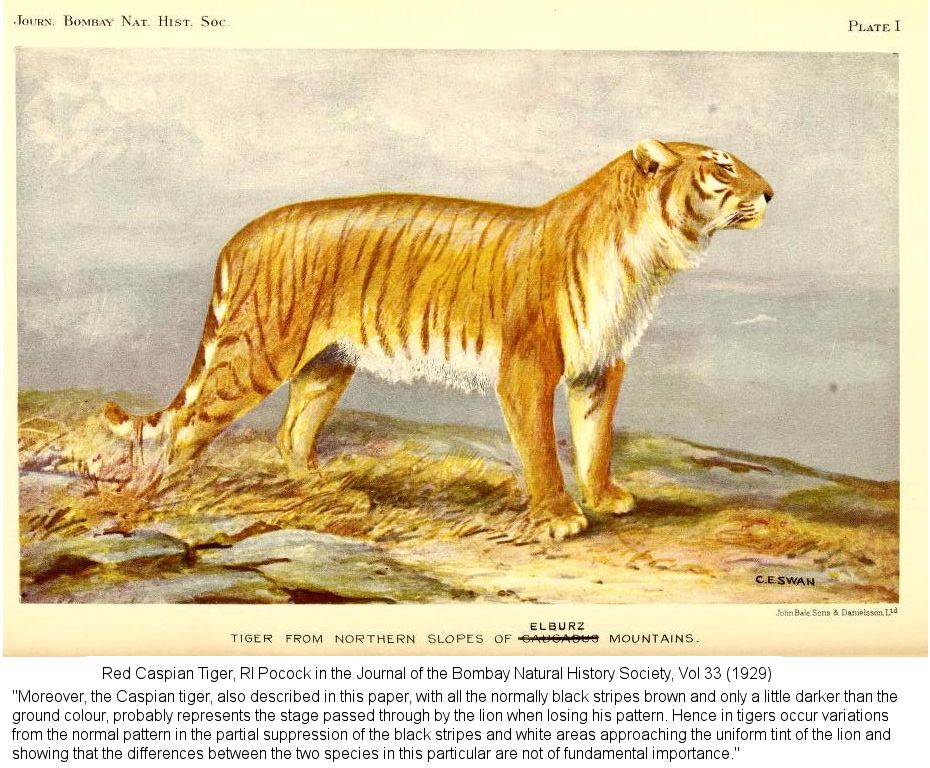
In the JBNHS, 1937 (v39: 1937-8), S H Prater of the Bombay Natural History Society wrote “Mr W H Carter (Times, 16 Oct 1936) writes ‘In one of the official district Gazetteers of Bengal (Khulna or Backerganj) there is mentioned a local variety of tiger which had lost its stripes as camouflage in the open sandy tracts of Sunderbans. The uniform colour scheme adopted was however, brown”. However this differs from the original report in “The Provincial Geography of India – Bengal, Bihar and Orissa, Sikkim,” by LSS O’Malley, 1917 which stated: “…those frequenting the sand dunes along the sea face of the Sundarbans have almost lost their stripes in adaptation to their environment, so that their coats are of a tawny orange with only a few dark lines” which suggests natural selection for a less heavily striped form.
In "Lions and Tigers and Mares, oh My!" (2004), Gay Louise Balliet wrote that Josip Marcan had been researching tiger colouration and colour genetics for around 20 years and was interested in the rarer colours. Marcan selectively breeds for the rarer colours. His tigers at the time included a golden tabby Bengal (Assam); a brown-striped beige (Jasmine); melanistic whites (chinchilla gene with black stripes) and grey-striped melanistic whites (chinchilla gene with dilution of black to grey). The brown-striped beige bred by Josip Marcan may be due to non-extension of the black gene i.e. red pigment (phaeomelanin) is produced instead of black (eumelanin).
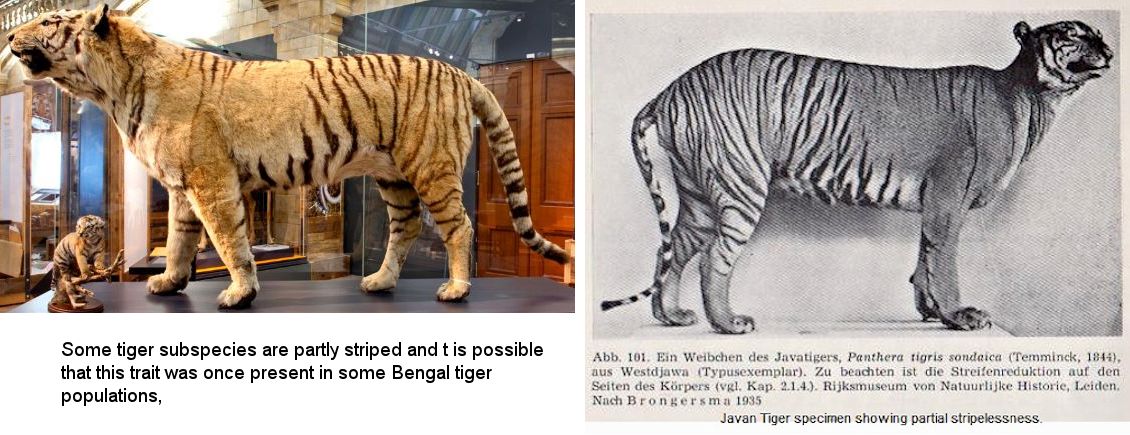
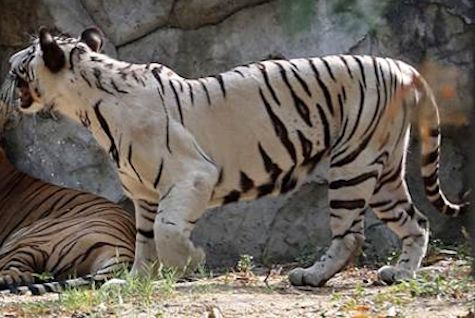

There are several reports of brown (i.e. orange) Bengal tigers with no stripes. In April 1989, the Indian Forester published a short article “Tiger without stripes” by S A Sagar and L A K Singh of Orissa's Similipal Tiger Reserve. They noted four different sightings, all made by experienced trackers, of stripeless tigers in 1961, 1977, 1979 and 1988. Like recent black tiger sightings these are located in a single geographical area and probably indicate inbreeding which is allowing recessive or aberrant genes to show up and be perpetuated. Red tigers display chocolate markings on a rich red background, though the distinction between brown tigers and red tigers is one made by the observer. The sightings were: (1) 1988: by a forest guard at N Similipal; (2) 1977: by an experienced tracker in NW Similipal; (3) 1979: by the same tracker in NE Similipal; (4) 1961: Observed by a senior officer of the IPS cadre in Chitrakonda close to Orissa-Andhra Pradesh border.
RED TIGERS display chocolate markings on a rich red background, though the distinction between brown tigers and red tigers is one made by the observer. In Indian Zoos, the term "brown tiger" is used to distinguish between orange tigers and white tigers. Some historical reports of red tigers may ref to the colour morph now known as golden (golden tabby).
An exceptionally rare PALE TIGER was photographed in the wild in southern India in 2017, and may be the palest known tiger living in the wild, the white colour morph now being extinct in the wild. The pale tiger, a sub-adult of unknown gender, was photographed by Nilanjan Ray in Nilgiri biosphere reserve in Tamil Nadu state. Pale tigers, which are distinct from white tigers, occur in environments with large, random mating pools and plenty of genetic diversity. A pale tiger was previously seen in the Ranthambore national park in Rajasthan in the 1980s, but was not as pale as the Tamil Nadu pale tiger. Unlike the mixed-blood pale tigers in captivity, this tiger is a pure Bengal tiger.
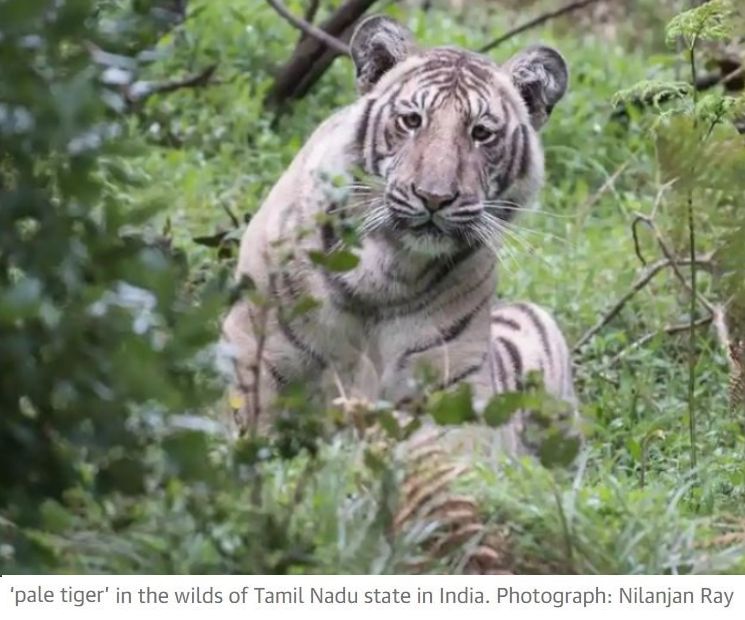
There have been unconfirmed reports from the Sunderbans of REVERSE STRIPED TIGERS whose coats have an abnormally dark background colour patterned with orange stripes. This is the reverse of the normal black-on-orange colouration. During 1996, yellow-striped black tigers were reported near Baladaghar and between Patabil and Devasthali. This may have been the cause of a SPOTTED TIGER where orange spots were present on a black background. This would appear to be a tiger form of pseudo-melanism/abundism, a colour variation that has been recorded in leopards. Others have dismissed the spotted tiger as an optical illusion caused by dappled shadows on a normally striped Bengal tiger.
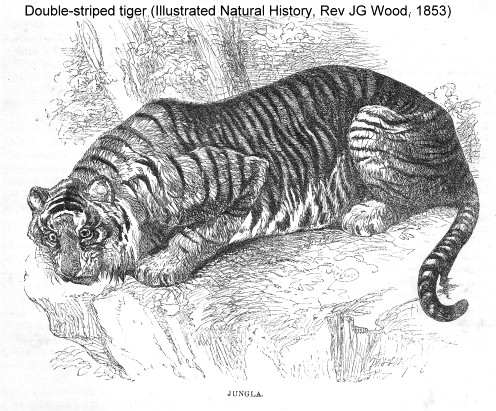
One of the most famous "DOUBLE STRIPED TIGER" was "Jungla", exhibited at Belle Vue Zoo, Manchester, during the 1850s (illustrated) and pitted against tigers and buffalo in fights. Reverend JG Wood wrote a detailed description a few years later for his "Illustrated Natural History". Jungla was then about 5 years old. In his "Illustrated Natural History" (1853, 1874) the Rev JG Wood writes:
“Jungla” is one of the finest, if not the very finest Tiger that has ever set foot on English ground, and even when penned in the straight limits of a wooden cage that would not permit his noble head to be raised to its full height, and only gave room for a single short step backwards and forwards, his grand proportions were most striking. His present age is about five years. In height he is about four feet, and the relative proportions can be judged from the illustration. The total length of the animal is said, by his keeper, to he thirteen feet six inches and in girth he measures four feet eight inches. The principal peculiarity in the appearance of this animal is, that nearly all the stripes are double, including those which partially surround the tail. Sometimes these dark streaks are very long, and sometimes comparatively short and very wide, leaving a broad interval of the golden-yellow fur between the outer and inner stripes. Between many of these streaks are placed a number of spots similar to those which appear on the leopard’s skin, but the spots are small in size and not so distinctly outlined as the stripes. They are rather thickly scattered by the shoulders and flanks, occasionally making their appearance on the sides. Over the eyes some black lines are drawn, which closely resemble a stag’s horn, and on the forehead runs a series of equally dark stripe. which remind the spectator of the figure of a bat with outstretched wings. The ears are black, with a solitary white spot upon the back of each ear.
His light yellow eyes are constantly changing their tint, at one moment becoming green, and at another time assuming a deep neutral tint. As is the case with all felines. The pupil of the eye varies rapidly in size, the passing of a hand near the front of the cage sufficient to make them contract to half their previous diameter. He has been matched against many antagonists, and always came off victorious in the fight, whether his opponent were a strong-horned and hard-headed buffalo, or a Tiger like himself. The last Tiger to which he was opposed was killed in fifteen minutes.
In November 1869, Mander's Menagerie, a large travelling exhibition in Britain, included in its stocklist "double striped royal Bengal tigers". Modern experts have suggested that the tiger was actually a Javan tiger (now extinct) as this had complex striping on its upper hind legs. Since then, a number of double striped Bengal tigers have been reported. A tiger's striping is variable ranging from fine double stripes like a mackerel tabby cat, through the normal pattern to heavy, broad stripes which partially obscure the background colour. The pattern depends on the sub-species to which the tiger belongs - some sub-species have minimal striping on the forequarters. In zoos, little regard was given as to which sub-species the tigers were when they were bred together and their descendants have intermediate patterns.
As well as unusual colours and patterns in tigers; tail-less tigers, intersexual tigers and tigers with unusually short tails have been reported. A short or absent tail could be due to either an accident, birth defect or gene mutation.
Textual content is licensed under the GFDL.
For more information on the genetics of colour and pattern:
Robinson's Genetics for Cat Breeders & Veterinarians 4th Ed (the current version)
Genetics for Cat Breeders, 3rd Ed by Roy Robinson (earlier version showing some of the historical misunderstandings)
Cat Genetics by A C Jude (1950s cat genetics text; demonstrates the early confusion that chinchilla was a form of albinism)
For more information on genetics, inheritance and gene pools see:
The Pros and Cons of Inbreeding
The Pros and Cons of Cloning
For more information on anomalous colour and pattern forms in big cats see
Karl Shuker's "Mystery Cats of the World" (Robert Hale: London, 1989 - some of the genetics content is outdated)
|
BACK TO HYBRID & MUTANT BIG CATS INDEX |